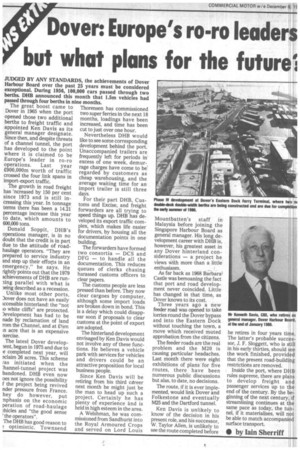Dover: Europe's ro-ro leaders but what plans for the future:
Page 26

If you've noticed an error in this article please click here to report it so we can fix it.
JUDGED BY ANY STANDARDS, the achievements of Dover Harbour Board over the past 25 years must be considered exceptional. During 1956, 100,000 cars passed through two berths. DHB announced this month that 1.5m vehicles had passed through four berths in nine months. The great boost came to Dover in 1965 when the port opened those two additional berths to freight traffic and appointed Ken Davis as its general manager designate. Since then, and despite threats of a channel tunnel, the port has developed to the point where it is claimed to be Europe's leader in ro-ro operations. Last year £900,000m worth of traffic crossed the four link spans in import-export traffic.
The growth in road freight has 'ncreased by 150 per cent since 1973 and is still increasing this year. In tonnage terms there has been a 14,21 percentage increase this year to date, which amounts to 600,000 tons.
Donald Soppit, DHB's operations manager, is in no doubt that the credit is in part due to the attitude of roadhaulage operators. "They are prepared to service industry and step up their effoKts in an emergency," he says. He tightly points out that the 1979 ichievements of DHB are runaing parallel with what is )eing described as a recession.
Unlike most other ports, Dover does not have an easily tccessible hinterland: the "not ;ci white cliffs" are protected.
Development has had to be nade by reclamation of land rom the Channel, and at E1/2m in acre that is an expensive ,xercise.
The latest Dover developlent, begun in 1975 and due to e completed next year, will claim 26 acres. This scheme ras initiated when the !hannel-tunnel project was bandoned. DHB even now oes not ignore the possibility I the project being revived nder pressure from France. hey do however, put .nphasis on the economic peration of road-haulage ?hides and "the good sense the operators".
The DHB has good reason to optimistic. Townsend Thorensen has commissioned two super ferries in the next 18 months, loadings have been increased, and time has been cut to just over one hour.
Nevertheless DHB would like to see some corresponding development behind the port. Unaccompanied trailers are frequently left for periods in excess of one week, demurrage charges have come to be regarded by customers as cheap warehousing, and the average waiting time for an import trailer is still three days.
For their part DHB, Customs and Excise, and freight forwarders are all trying to speed things up. DHB has developed its export traffic complex, which makes life easier for drivers, by housing all the documentation points in one building.
The forwarders have formed two consortia — DCS and DFG — to handle all the documentation. This reduces queues of clerks chasing harassed customs officers to clear papers.
The customs people are less pressed than before. They now clear cargoes by computer, although some import loads are broken down in bond. This is a delay which could disappear soon if proposals to clear customs at the point of export are adopted.
The hinterland development envisaged by Ken Davis would not involve any of these functions. He believes a vehicle park with services for vehicles and drivers could be an attractive proposition for local business people.
Since Ken Davis will be retiring from his third career next month he might just be the man to head up such a project. Certainly he has plenty of experience and is held in high esteem in the area.
A Welshman, he was commissioned from Sandhurst into the Royal Armoured Crops and served on Lord Louis Mountbatten's staff in Malaysia before joining the Singapore Harbour Board as general manager. His long development career with DHB is, however, his greatest asset in any Dover hinterland considerations — a project he views With more than a little enthusiasm. — As far back as 1968 Barbara, Castle was bemoaning the fact that port and road development never coincided. Little has changed in that time, as Dover knows to its cost.
Three years ago a new feeder road was opened to take lorries round the Dover bypass and into the Eastern Dock without touching the town, a move which received muted approbation from the citizens.
The feeder roads are the real problem and the M20 is causing particular headaches. Last month there were eight exhibitions of plans for five routes, there have been numerous public discussions but alas, to date, no decisions.
The route, if it is ever implemented, would link Dover and Folkestone and eventually M25 and the Dartford tunnel.
Ken Davis is unlikely to know of the decision in his present role, and his successor, W. Taylor Allen, is unlikely to see the route completed before he retires in four years time. The latter's probable successor, J. F. Sloggett, who is still in his early thirties, should see the work finished, provided that the present road-building restrictions are removed.
Inside the port, where DHB' rules supreme, there are plans to develop freight and passenger services up to the end of the century. By the beginning of the next century, if streamlining continues at the same pace as today, the tunnel, if it materialises, will not be able to match accompanied surface transport.
• by bin Sherriff
























































































































































